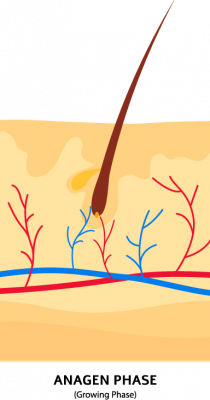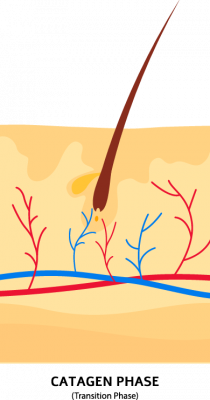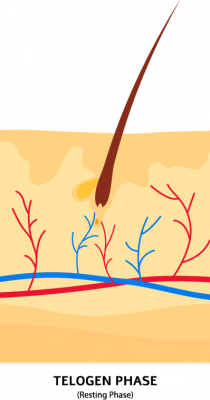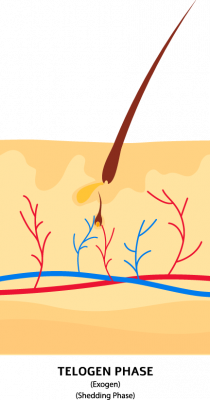Understanding the Hair Growth Cycle
How Does Your Hair Grow?
Hair grows in a cycle that consists of three phases: Anagen, Catagen and Telogen
1. Anagen
This is the growth phase that lasts between two and eight years. Eighty five percent of the hair should be in this cycle. For pregnant women, it goes up to ninety five percent and then it goes to the Telogen (fall out) cycle after delivery. During the anagen phase the growth cells in the papilla rapidly divide and produce the hair shaft which becomes keratinized as it pushes up and out of the follicle into the pore. At the same time, the follicle grows down into the deeper levels of the dermis (skin) to get nourishment. People who have long anagen growth rates are able to grow very long hair and others have short growth phases and cannot grow very long hair. Hair grows at a rate of about a ½ inch per month, so a hair left uncut will grow to a length of between 12 inches and 48 inches.

2. Catagen
The catagen phase is followed by a brief two to four week cycle in the catagen phase or transitional phase. One percent of the hair is in this phase. This is part of a renewal process where the follicle is degraded and the hair stops growing but does not fall out. During the catagen phase the hair follicle shrinks to about 1/6 of the normal length. The lower part is destroyed, the dermal papilla breaks away, the bulb detaches from the blood supply and the hair shaft eventually is pushed up as the follicle disintegrates.

3. Telogen
The follicle then goes into the telogen or resting phase for two to four months, during this time the hair still does not grow but remains attached to the follicle while the dermal papilla is in a resting phase below. Fourteen percent 14 percent of all hairs are in this phase at any one time. Abruptly stopping birth control pills after a long period of time or anemia can force hair into this cycle. After the telogen phase the cycle is complete and the hair goes back into the Anagen phase. It is at this time when the new hair shaft is forming that the old hair is pushed out and lost. On average 50-100 hairs are lost due to this natural growth process every day. This is normal hair loss and accounts for the hair loss seen every day in the shower and with hair combing. In healthy follicles these hairs will soon be replaced by new hair. A variety of factors can alter the normal hair growth cycle and cause temporary or permanent hair loss including medication, radiation, chemotherapy, exposure to chemicals, hormonal and nutritional factors, thyroid disease, generalized or local skin disease, and stress.

4. Exogen
Exogen is an extension of the telogen stage lasting for two to five months. New hairs begin to grow in the follicles as the old hairs fall away.

Get the latest updates first!
Let’s Connect
If you would like to schedule a consultation to discuss your hair and scalp treatment feel free to contact us using the form below.

